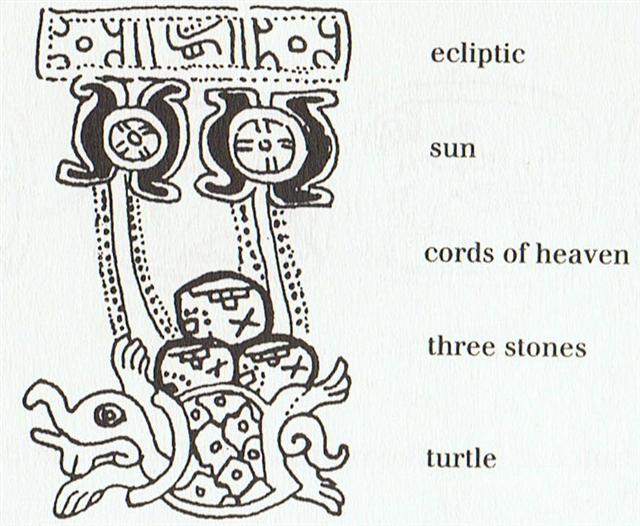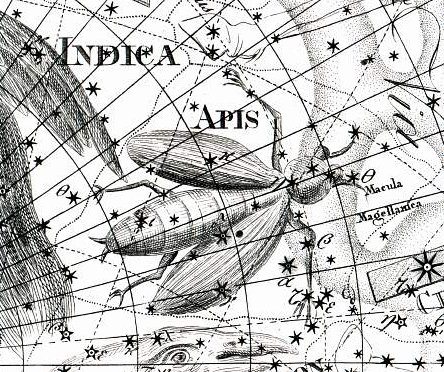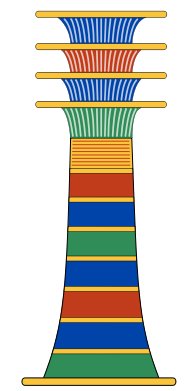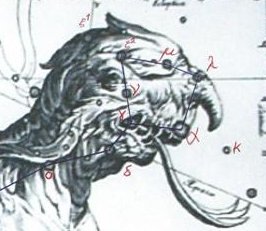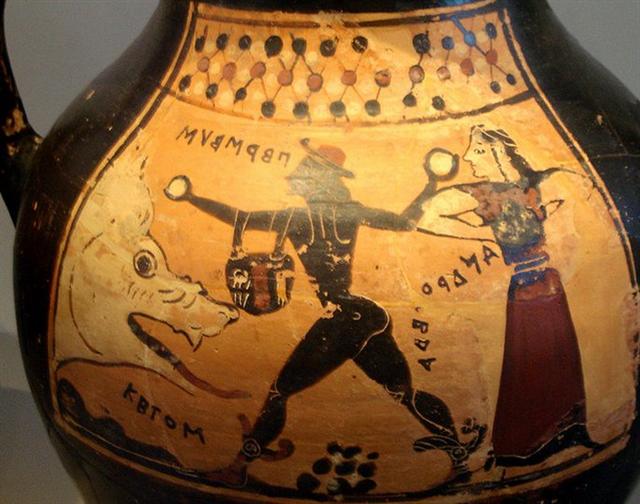|
TAHUA
29 The number of days in summer was not the same as the number of nights in the year for winter time. Assuming an ideal year to measure 364 (→ 300 + 64) right ascension days, we could imagine the pair 364 = 180 + 184 and 181 (→ Sirius) + 184 = 365.
From where we then might connect the difference 184 - 181 with those three (toru) days of the old Chinese custom demanding 3 days (→ tau toru) for eating only cold food: ... In China, every year about the beginning of April, certain officials called Sz'hüen used of old to go about the country armed with wooden clappers. Their business was to summon the people and command them to put out every fire. This was the beginning of the season called Han-shih-tsieh, or 'eating of cold food'. For three days all household fires remained extinct as a preparation for the solemn renewal of the fire, which took place on the fifth or sixth day after the winter solstice ...
And then, shifting to observations of the Full Moon, we could imagine 177 (→ 6 * 29½) + 183 (366 / 2) = 360 (→ 360º) = 2 * (177 + 3) = 354 + six (ono). ... Matua said to Hotu, 'Take along the Hanau Eepe and let them work the land!' Hotu called out to Teke: 'Go along and bring the 500 prisoners on board the canoe!' He took all of them along, led them on board the canoe, and left them there. For six days (po ono), mats (moenga) were taken on board the canoe (i.e., the loading of the canoe took six days). ... A sidelight falls upon the notions connected with the stag by Horapollo's statement concerning the Egyptian writing of 'A long space of time: A Stag's horns grow out each year. A picture of them means a long space of time.' Chairemon (hieroglyph no. 15, quoted by Tzetzes) made it shorter: 'eniautos: elaphos'. Louis Keimer, stressing the absence of stags in Egypt, pointed to the Oryx (Capra Nubiana) as the appropriate 'ersatz', whose head was, indeed, used for writing the word rnp = year, eventually in 'the Lord of the Year', a well-known title of Ptah. Rare as this modus of writing the word seems to have been - the Wörterbuch der Aegyptischen Sprache (eds. Erman and Grapow), vol. 2, pp. 429-33, does not even mention this variant - it is worth considering (as in every subject dealt with by Keimer), the more so as Chairemon continues his list by offering as number 16: 'eniautos: phoinix', i.e., a different span of time, the much-discussed 'Phoenix-period' (ca. 500 years) ...
... Hotu's canoe sailed from Maori to Te Pito O Te Kainga (Easter Island). It sailed on the second (2) day of September (hora nui) ... [E:73-74] Pito. 1. Umbilical cord; navel; centre of something: te pito o te henua, centre of the world. Ana poreko te poki, ina ekó rivariva mo uru ki roto ki te hare o here'u i te poki; e-nanagi te pito o te poki, ai ka-rivariva mo uru ki roto ki te hare, when a child is born one must not enter the house immediately, for fear of injuring the child (that is, by breaking the taboo on a house where birth takes place); only after the umbilical cord has been severed can one enter the house. 2. Also something used for doing one's buttons up (buttonhole?). Vanaga. Navel. Churchill. H Piko 1. Navel, navel string, umbilical cord. Fig. blood relative, genitals. Cfr piko pau 'iole, wai'olu. Mō ka piko, moku ka piko, wehe i ka piko, the navel cord is cut [friendship between related persons is broken; a relative is cast out of a family]. Pehea kō piko? How is your navel (a facetious greeting avoided by some because of the double meaning)? 2. Summit or top of a hill or mountain; crest; crown of the head; crown of the hat made on a frame (pāpale pahu); tip of the ear; end of a rope; border of a land; center, as of a fishpond wall or kōnane board; place where a stem is attached to the leaf, as of taro. 3. Short for alopiko. I ka piko nō 'oe, lihaliha (song), at the belly portion itself, so very choice and fat. 4. A common taro with many varieties, all with the leaf blade indented at the base up to the piko, junction of blade and stem. 5. Design in plaiting the hat called pāpale 'ie. 6. Bottom round of a carrying net, kōkō. 7. Small wauke rootlets from an old plant. 8. Thatch above a door. 'Oki i ka piko, to cut this thatch; fig. to dedicate a house. Wehewehe. In the C text 6 days were clearly pointed out at the beginning both of the text on side a and at the beginning of its side b:
By relying on my interpretation of the G text it became obvious for me that my earlier description of line Cb1 with *32 = *215 - *183 had to be changed so that it would be Mira at the opposite side of Arcturus. ... Although an old constellation, Cetus is by no means of special interest, except as possessing the south pole of the Milky Way and the Wonderful Star, the variable Mira; and from the fact that it is a condensation point of nebulae directly across the sphere from Virgo, also noted in this respect ... ... Mira also known as Omicron Ceti (ο Ceti, ο Cet), is a red giant star estimated 200-400 light years away in the constellation Cetus. Mira is a binary star, consisting of the red giant Mira A along with Mira B. Mira A is also an oscillating variable star and was the first non-supernova variable star discovered, with the possible exception of Algol. Apart from the unusual Eta Carinae, Mira is the brightest periodic variable in the sky that is not visible to the naked eye for part of its cycle ... ... In 1638 Johannes Holwarda determined a period of the star's reappearances, eleven months; he is often credited with the discovery of Mira's variability. Johannes Hevelius was observing it at the same time and named it 'Mira' (meaning 'wonderful' or 'astonishing,' in Latin) in 1662's Historiola Mirae Stellae, for it acted like no other known star. Ismail Bouillaud then estimated its period at 333 days, less than one day off the modern value of 332 days, and perfectly forgivable, as Mira is known to vary slightly in period, and may even be slowly changing over time ...
We should here notice that Aa6-83 (six days after king iko) has a structure like that in Ca1-6:
|
|||||||||||||||||||||||||||||||||||||||||||||||||||||||||||||||||||||||||||||||||||||||||||||||||||||||||||||||||||||||||||||||||||||||||||||||||||||||||||||||||||||
